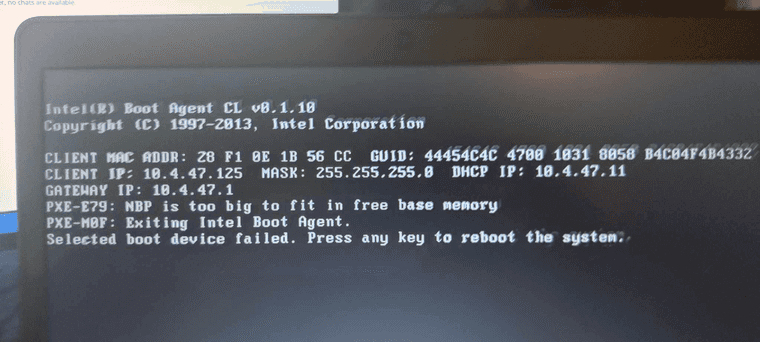issues with deploying on UEFI computers
-
@dsutton2001 Hello, I made that switch, and now legacy devices can’t boot to fog.

-
@anwoke8204 How were they before?
Legacy devices wouldn’t have worked with snponly.efi
Seeing as your post was specific to UEFI computers, and ipxe.efi works for this, I would say this issue is addressed.
However, since you’re now saying that “legacy doesn’t work with ipxe.efi as the boot file”
Have a look over this wiki:
https://wiki.fogproject.org/wiki/index.php/BIOS_and_UEFI_Co-Existence -
@anwoke8204 In the system BIOS, look for a setting called “Enable UEFI network stack.” That’s the setting name on most Dells.
-
Another thing to check is the system time in the BIOS. I’ve seen instances where the BIOS data/time was reset, causing the date to be prior to the FOG certificate’s valid period, causing the permission denied error.
-
@Tom-Elliott we have both legacy and uefi systems in our environment. I know there is a way to booth both because we have sone it before on an old fog server. I just can’t seem to remember what setting or changes I made to either the fog server or dhcp to allow both to boot.
-
@anwoke8204 Well your first screenshot indicates that you already successfully booted UEFI PXE, but it stops at chaining boot.php via HTTPS.
First thing to try is browse to https://10.4.47.15/fog/service/ipxe/boot.php from a desktop. If it loads and you can see the script, then you know the web service is working correctly. Since you are using HTTPS which uses a self-signed cert that has a validity period, I suggested you check the system date and time in your BIOS. -
@anwoke8204 What device is your dhcp server? Your solution to booting both is with that device.
If your dhcp server is a fog server then it automatically supports both bios and uefi pxe booting. If you have a windows 2016 or later dhcp server then the steps are here to create your profiles. Look in the windows section
https://wiki.fogproject.org/wiki/index.php/BIOS_and_UEFI_Co-Existence
If your dhcp server is a router, then we should look towards a utility called dnsmasq to configure dynamic pxe booting.
-
@george1421 Hello, we did that and most works for the most part now, but we have some tablets that require a USB NIC that aren’t booting still, but every bios system and every UEFI system that has an onboard nic is now booting. Any idea on how to get the USB Network cards to boot? the 2 that we have noticed issues with so far are ASIX AX88179 USB 3 to gigabit Ethernet Adapter and AX88179A USB 3 to gigabit Ethernet Adapter.
-
@anwoke8204 said in issues with deploying on UEFI computers:
Any idea on how to get the USB Network cards to boot?
For these usb nic cards they need to be supported by either bios or uefi firmware or they won’t pxe boot. Its not a fog or dhcp issue, its a potential conflict between the hardware and uefi.
With that said we do have a method to usb boot into fog imaging. There are some drawbacks to this method, but if all you need to do is clone computers it should work.
-
With that said we do have a method to usb boot into fog imaging. There are some drawbacks to this method, but if all you need to do is clone computers it should work.
What is this method?
-
@anwoke8204 If your computer is uefi based, lets try the easy method first. https://forums.fogproject.org/topic/6350/usb-boot-uefi-client-into-fog-menu-easy-way
By using the easy method above, you can retain all of the features of the FOG preboot environment. If that method doesn’t work we can build FOS Linux on a usb flash drive and boot that way. Its a little more complicated to setup but I have an image already created you can use. https://forums.fogproject.org/topic/7727/building-usb-booting-fos-image the previous link is the instructions to build it yourself. Make sure you read through the caveats if you go this route.